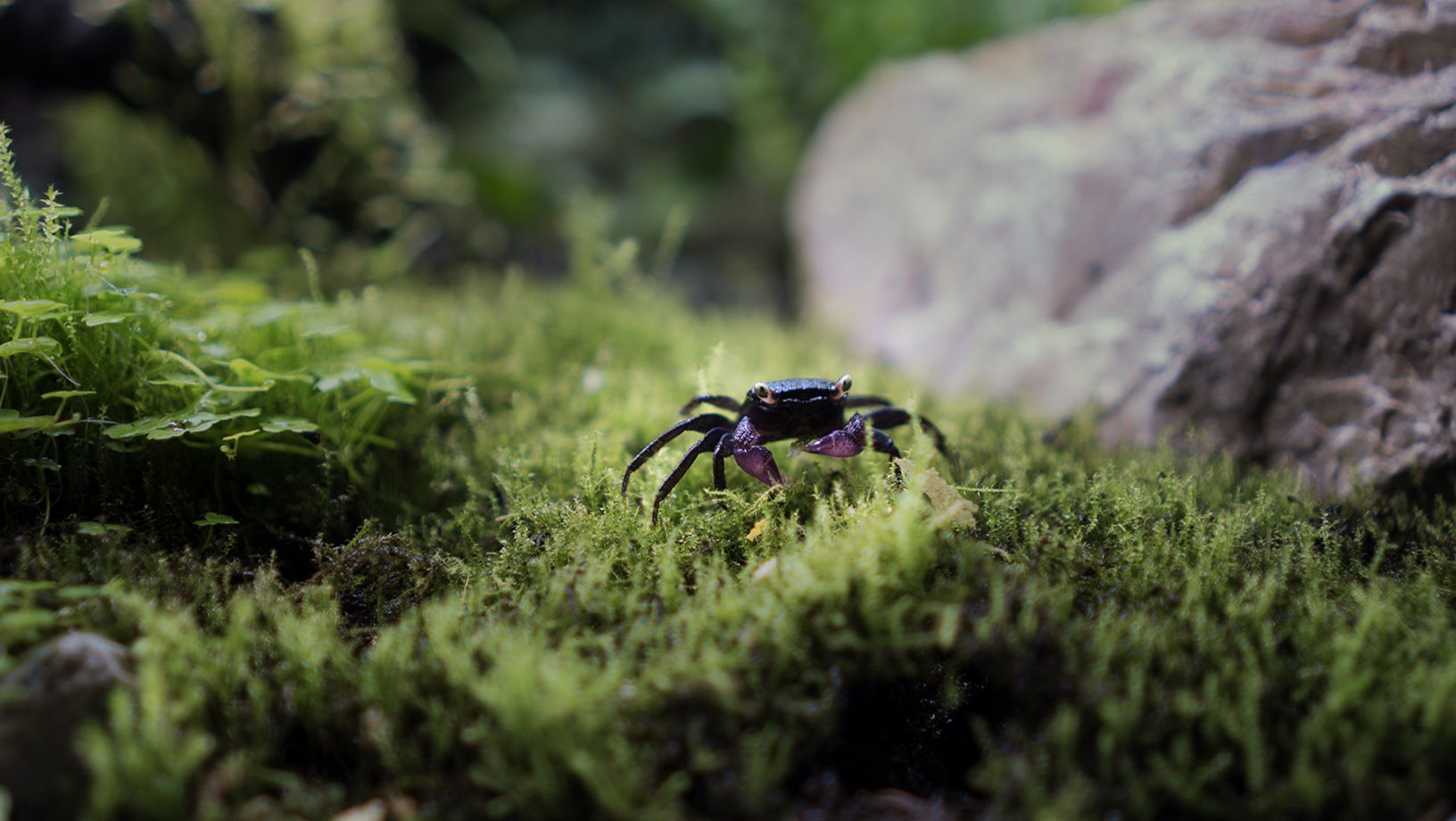Pet Arthropods and Molting

What are arthropods?
Arthropods are animals that belong to the phylum Arthropoda. To be even more specific, arthropods are invertebrates (animals without a spine) who have a segmented body, jointed limbs, and a hard exoskeleton. An exoskeleton is a harder shell-like material that covers the animal’s entire body, kind of like a suit of armor. The exoskeleton provides structure and form for the animal, just like our own internal skeleton does for us! Common arthropods in the pet industry include tarantulas, jumping spiders, scorpions, hermit crabs, other crab varieties like vampire crabs and red claw crabs, and even tiny aquarium occupants like shrimp!
What is Molting?
Molting is the process arthropods go through in order to grow. They do this by shedding their exoskeleton and growing a new one that’s usually a little bit larger. How many times an animal molts over the course of their life, and how often they molt, will vary by species. Some species, like crabs, molt regularly over the course of their entire life, averaging about once a month but slowly becoming less frequent as the crab ages. Meanwhile other species, like tarantulas, molt about once a month when they’re juveniles but slow down to once or twice a year as adults. On the other end of the spectrum, jumping spiders only molt when they’re juveniles and no longer molt at all once they are adults. This is to say that the number of times your pet will molt over the course of their life will vary depending on the specific animal(s) you own, and could range from never molting at all while in your care to molting every month!
Are There Signs My Pet IS About to Molt?
Depending on the species, there are different signs to watch for that may indicate your pet is preparing to molt. Some common signs include decreased energy, refusing food, and spending increased time hiding. Many arthropods will spend more time in burrows or hiding around their enclosure as they search for a safe space to molt. You may also notice your pet is less active, as they are conserving their energy. Sometimes their appetite will decrease right before molting, or they may refuse a normal meal entirely. Another sign you may notice, depending on the species, is your pet may look dull in color or appear almost cloudy in appearance. This is more common in aquatic pets, like crabs and shrimp, but can sometimes also be seen in brighter colored pets too like some tarantulas.
Other, less common signs you may see are visible separation of the old exoskeleton at the joints You may also notice that your pet’s body look swollen, or their body might look “tight”, as if they are going to pop. As the old exoskeleton prepares to separate, it may become deformed in some places.
What happens when my pet molts?
As we established earlier, molting involves an arthropod fully shedding it’s old exoskeleton and growing a new one. This is a very time consuming, exhausting process for your pet. While usually accomplished over the course of 12-24hrs, every animal is different and every molt will be a little different from the previous one.
Normally what will happen is your pet will choose a spot where they feel safe and secure, maybe inside a hide, in a corner of the habitat, under foliage or for spiders they may molt inside one of their web-dens or hammocks. Your pet will first take its time to carefully emerge from its old exoskeleton, which is now more of a shell. Once finally free of their old exoskeleton, your pet is incredibly fragile. Freshly molted, your pet’s new exoskeleton is not yet fully formed- it is still fresh and has not had time to become solid. Over the next 24-48hrs, your pet’s new exoskeleton will gradually harden until it is solid. Until that happens, do not try to handle your pet. For arachnids (spiders and scorpions), do not offer any prey until at least 2-3 days after molting to ensure their new fangs, claws and stingers are fully hardened so that they can safely hunt and eat.
After molting, most crabs will eat their old exoskeleton but you can remove it after a day if they do not eat it. Tarantula and scorpion molts should be removed from the enclosure. If you have a jumping spider that molts, you can remove the molt if it will not disturb any webbing, but they often will use their old molt to anchor their webbing to. Prior to removing the molt, observe its location and determine if removing the molt will cause damage to the hammock’s webbing. Additionally, you may want to observe your spider’s behavior to determine if the hammock is one being regularly used or not. If the molt is integral to a regularly used hammock, leave it alone. If the hammock the molt is in is no longer used by your spider, or if your spider kicked their molt out of the hammock themselves, then it is likely okay to remove it.
Should I help my pet molt?
Sometimes while molting, an animal may appear to be stuck in their old exoskeleton. As tempting as it is, do not intervene. Because your pet is very delicate in this state, attempting to assist can have severe consequences for your pet. Attempts to help your pet during a molt can result in injury to your pet, loss of limbs, or even worse. The best thing you can do for your pet when they are molting is to make sure to keep their habitat nice and humid and keep an eye on them. For crabs, because they molt in water, this means making sure there is always a reservoir of water available in their tank for them to be able to molt in.
Unfortunately, one of the riskiest things your arthropod pet will go through is molting. A “failed molt” is a molt in which the animal was unable to fully evacuate its old exoskeleton and unfortunately passes away. This can happen for a variety of reasons, including but not limited to: incorrect temperature, improper humidity, nutrient deficiency (e.g. calcium or magnesium), stress, underlying disease or genetic defects. Even old age can contribute to a failed molt, as molting is very labor intensive process and some older animals may not have the energy required to complete the process.
How can I help promote a healthy molt?
Ensuring a healthy molt is essential for the well-being of pet arthropods. Because molting is a vulnerable process, proper care and husbandry can minimize the risk of complications or "failed molts." Here are evidence-based practices for promoting healthy molts:
- Maintain Proper Humidity and Hydration
- Research Your Species: Optimal humidity levels differ between species (e.g., tarantulas versus crabs), so always check the specific needs of your pet.
- Provide Fresh Water: Ensure constant access to clean water. For aquatic species, keep water parameters stable and unpolluted.
- Mist the Habitat: For terrestrial species, gentle misting can help, but avoid oversaturation to prevent mold.
- Humidity Hides: Consider a "moist hide" (a refuge with damp substrate) for species that benefit from localized humidity.
- Ensure Appropriate Temperature
- Stable Environment: Maintain temperatures within the recommended range for your species to promote proper metabolic and molting processes.
- Avoid Extremes: Sudden drops or increases can stress your pet and disrupt their molt.
- Provide a Safe, Stress-Free Environment
- Minimize Disturbances: Limit handling and avoid rearranging the habitat during pre-molt and molting periods.
- Hiding Spots: Supply hides, shelters, or burrows where your pet can molt in privacy and safety.
- Offer a Balanced Diet and Essential Nutrients
- Protein and Calcium: Nutritional deficiencies, especially of proteins, calcium, and other minerals, can cause molting problems—particularly in crustaceans and insects.
- Varied Diet: Feed an appropriate variety of foods designed for your species' needs.
- Supplement if Needed: Some species, like crabs, benefit from calcium-rich foods (e.g., cuttlebone pieces).
- Regular Enclosure Maintenance
- Cleanliness: Keep the enclosure clean but avoid deep cleaning or introducing changes just before molt.
- Monitor Substrate: For burrowing species, allow for enough depth of substrate so they can dig if needed.
- Recognize Pre-Molt Signs and Adjust Care
- Identify Pre-Molt Behavior: Reduced appetite, reclusiveness, and dull coloration usually signal an approaching molt.
- Withhold Food: Do not offer prey to spiders or scorpions showing clear pre-molt signs, as uneaten prey can injure a vulnerable molting arthropod.
- Avoid Intervention During Molting
- Hands Off: Never try to help your arthropod shed its exoskeleton (unless following expert veterinary advice). Intervention almost always causes harm.
- Monitor Molt Recovery
- Post-Molt Rest: Allow several days for the new exoskeleton to harden before handling or feeding your pet again.
- Check for Issues: Observe for any signs of incomplete shedding, deformities, or distress post-molt.
Providing an optimal environment, proper nutrition, and minimal stress are the most critical factors in helping your pet arthropod molt safely. If you observe signs of distress or suspect a failed molt, consult a veterinarian with exotic pet experience.
Related guides:

